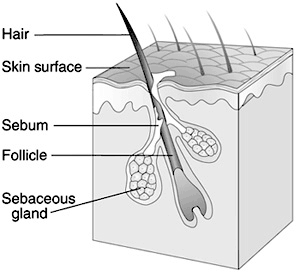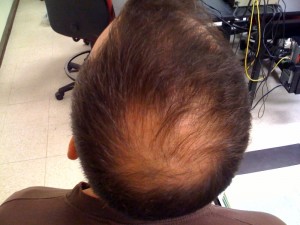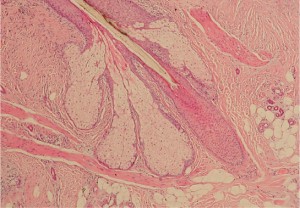The Roots of Hair Loss
Balding is no joke. As your luscious locks thin out, your floors and shower drains collecting what once lay gracefully across your scalp, it’s normal to feel frustration or diminishing confidence. Hair loss affects both men and women, but men see these difficulties at much higher rates.
There are a great number of causes that can drive hair loss. Before we go over a few of those causes, let’s take a look at the overall process.
It Begins With a Follicle
Hair follicles lay in the outer layers of our skin, everywhere except the palms of our hands and the soles of our feet. They produce a protein called Keratin, a key structural component that makes up both our hair and nails.
Sebaceous glands are attached to the follicles, and secrete an oily matter called sebum that works to lubricate and protect our skin and hair.
The more sebaceous glands attached to a follicle, the thicker the hair.
The life cycle is divided into three phases, with the last one being a resting phase. During the resting phase, you’ll shed a hair and the follicle will rest for two to three months. If it’s a healthy follicle, however, it’ll begin growing a new hair as soon as that phase has passed.
If you have a dead follicle, however, that hair will not regrow. You cannot revive a dead hair follicle, which is why it is important to keep your existing healthy hair follicles in optimum health.
Treatments exist that will help thicken and strengthen hair, creating the appearance of more natural hair growth, but the dead follicles will not come back to life.
What’s Hurting Your Strands
To understand how to slow or prevent hair loss, we first need to understand what’s causing it. Common issues can include:
- Hereditary Conditions
- Hormonal Changes
- Medical Conditions
- Stress & Illness
- Drugs
Contrary to popular belief, wearing a hat or brushing your hair too often will not cause hair loss. You should be careful to avoid breakage, but you will not see dead follicles as a direct result of styling. As it is normal to lose around 100 hairs a day, finding a few strands in your brush is not a cause for alarm.
Build-up of DHT, a male sex hormone, can affect the health of your follicles as well. Simultaneously, poor blood flow to the scalp, inflammation, and nutritional deficiencies can exacerbate the process.
Taking Care of Your Hair
Preventing or slowing hair loss is far easier and less costly than getting it back. For the best results, you need a multilayered approach.
This involves tackling key nutrient deficiencies from within, clearing damaging compounds from your scalp, and enriching your scalp with a topical solution that can help protect and nourish throughout the day. Be sure to avoid chemicals and unnatural preservatives, as these can work against your goals in the long run.
It’s shameless plug time again. For a great multilayered system packed with natural ingredients and pure essential oils, try the VytaHair 3-Step System. This unique system includes:
- Revitalizing Foaming Topical
- Targeted Nutritional Supplement
- Fortifying Shampoo
You can read the full product brochure here. See the full product page here or by clicking the Products tab in the menu bar above.
Still hesitant?
While there’s no time like the present, especially when it comes to hair loss prevention, we understand. A good starting point, however, could be to try out a cleansing supplement.
Toxins in our bodies are released through sweat across our skin, including that of your scalp. A colon cleanse supplement can help by acting as a detox to remove harmful substances from your body. As a result, you can see great impacts to your overall health. Not just in terms of your skin, but with more energy and less bloating as well.
Check out the powerful cleansing supplement Slim Cleanse Plus now.
The following websites were used to gather the data outlined here:
http://www.realsimple.com/beauty-fashion/skincare/worry-about-parabens-00000000028428/
http://www.webmd.com/skin-problems-and-treatments/hair-loss/
http://www.medicalnewstoday.com/articles/68082.php
http://www.webmd.com/skin-problems-and-treatments/guide/understanding-hair-loss-basics






